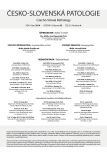Possibilities of molecular genetic determination of age of an individual from biological traces
Authors:
Marie Korabečná
Authors‘ workplace:
Ústav biologie a lékařské genetiky 1. lékařské fakulty UK a Všeobecné fakultní nemocnice, Praha
Published in:
Soud Lék., 59, 2014, No. 4, p. 52-54
Category:
Review
Overview
Application of molecular genetic methods during the examination of biological traces is irreplaceable for individual identification of their originators. However, this analysis does not provide any clues for further investigation without the possibility to compare the genetic profile of the examined trace with the profile of its potential originator. The age of a searched person represents an important entry for investigators. In this review, the recent methodical molecular genetic approaches are discussed with regards to their practical outputs leading to the estimation of biological age of an individual. The length of telomeric sequences and their attritions correlating with increasing age seemed to be very promising marker if they have been examined using Southern blot analysis. This method is not suitable for forensic casework due to the need of high amounts of DNA input. Recent methods based on quantitative polymerase chain reaction (qPCR) are applicable on samples with minimal DNA concentrations but they provide inconclusive results with regard to the age estimation based on the length of telomeres. Therefore novel methodical approaches were developed. Application of methods based on the examination of deletions in mitochondrial DNA, on the presence of transcripts of gamma hemoglobins or on the quantification of byproducts of somatic rearrangements of genes for T-cell receptors is restricted to special types of biological traces. The age dependent methylation of specific nucleotides in selected gene sequences seems to be the only promising universal marker.
Keywords:
age estimation – molecular genetics – telomere attrition – qPCR – array technology – promoter methylation
Sources
1. Zhao Z, Pan X, Liu L, Liu N. Telomere Length Maintenance, Shortening, and Lengthening. J Cell Physiol 2014; 229(10): 1323-9.
2. Saeed M, Berlin RM, Cruz TD. Exploring the utility of genetic markers for predicting biological age. Leg Med (Tokyo) 2012; 14(6): 279–285.
3. Tsuji A, Ishiko A, Takasaki T, Ikeda N. Estimating age of humans based on telomere shortening. Forensic Sci Int 2002; 126(3): 197–199.
4. Ren F, Li C, Xi H, Wen Y, Huang K. Estimation of human age according to telomere shortening in peripheral blood leukocytes of Tibetan. Am J Forensic Med Pathol 2009; 30(3): 252–255.
5. Takasaki T, Tsuji A, Ikeda N, Ohishi M. Age estimation in dental pulp DNA based on human telomere shortening. Int J Legal Med 2003; 117(4): 232–234.
6. Cawthon RM. Telomere measurement by quantitative PCR. Nucleic Acids Res 2002; 30 : 1–6.
7. Cawthon RM. Telomere length measurement by a novel monochrome multiplex quantitative PCR method. Nucleic Acids Res 2009; 37(3): e21.
8. Karlsson AO, Svensson A, Marklund A, Holmlund G. Estimating human age in forensic samples by analysis of telomere repeats. Forensic Sci Int Genetics Suppl 2008; 1(1): 569–571.
9. Hewakapuge S, Van Oorschot R, Lewandowski P, Baindur-Hudson S. Investigation of telomere lengths measurement by quantitative real-time PCR to predict age. Leg Med 2008; 10(5): 236–242.
10. Takubo K, Izumiyama-Shimomura N, Honma N, et al. Telomere lengths are characteristic in each human individual. Exp Gerontol 2002; 37(4): 523–531.
11. Nordfjall K, Svenson U, Norrback KF, Adolfsson R, Lenner P, Roos G. The individual blood cell telomere attrition rate is telomere length dependent. PLoS Genet 2009; 5(2): e1000375.
12. Kimura M, Cherkas LF, Kato BS, et al. Offspring’s leukocyte telomere length, paternal age, and telomere elongation in sperm. PLoS Genet 2008; 4(2): e37.
13. Unryn BM, Cook LS, Raibowol KT. Paternal age is positively linked to telomere length of children. Aging Cell 2005; 4(2): 97–101.
14. Meissner C, Ritz-Timme S. Molecular pathology and age estimation. Forensic Sci Int 2010; 203(1–3): 34–43.
15. Alvarez M, Ballantyne J. The identification of newborn using messenger RNA profiling analysis. Anal Biochem 2006; 357(1): 21–34.
16. Zubakov D, Liu F, van Zelm MC, et al. Estimating human age from T-cell DNA rearrangements. Curr Biol 2010; 20(22): R970–R971.
17. Bocklandt S, Lin W, Sehl ME, et al. Epigenetic predictor of age. PLoS One 2011; 6(6): e14821.
18. Koch CM, Wagner W. Epigenetic-aging-signature to determine age in different tissues. Aging (Albany NY) 2011; 3(10): 1018–1027.
Labels
Anatomical pathology Forensic medical examiner ToxicologyArticle was published in
Forensic Medicine

2014 Issue 4
Most read in this issue
- Causes of death and heart pathology in pacemaker or implantable cardioverter-def ibrillator patients who died in hospital
- Ethanol-induced ketoacidosis as a possible neglected cause of sudden death in chronic alcohol consumers
- Possibilities of molecular genetic determination of age of an individual from biological traces
- Pathomorphology of inflammatory response following traumatic brain injury, serum values of interleukins, and gene polymorphisms
